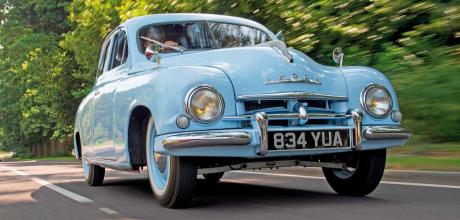1955 Škoda 1200
Fancy owning classic Škoda built in the days when the Iron Curtain hung heavily over Eastern Europe? Then look no further as this rare 1200 is looking for a new home. Words Iain Wakefield. Photography Matthew Richardson.
CZECH MATE
SKODA 1200 RESTORATION The full restoration of a mid-1950s Czech treasure, found in a dealer’s showroom as an exhibit.
Once the butt of a string of bar room jokes throughout the Seventies and early Eighties, Škoda Auto has come a long way since those dark days. Models like the cheap-aschips S100/S110 and the later, heavily revised Estelle and sporting Rapid were prime examples of the huge gulf that existed in technology between car manufactures based in Western Europe and those operating behind the Iron Curtain in Eastern Bloc territories such as Czechoslovakia where Škoda Auto is still based.
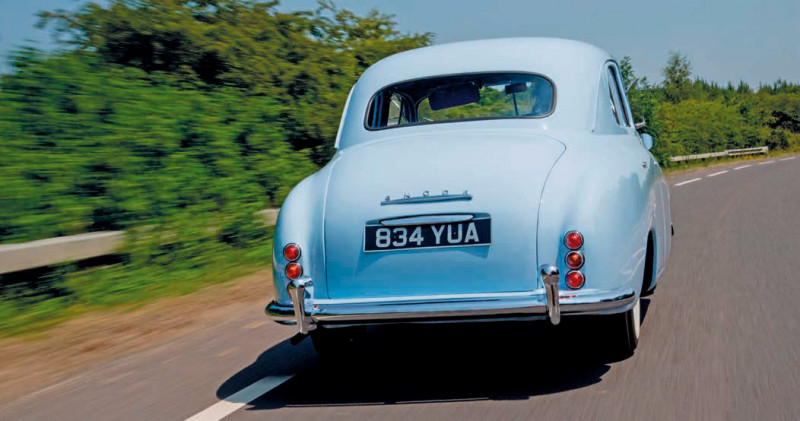
It wasn’t always like that though, as back in the early Fifties, communist-controlled Škoda Auto was producing a range of good-looking cars that included the 1098cc 1101 series. These tough little family cars were built in the time-honoured body-on-frame manner and were capable of coping with the worst of Czechoslovakia’s notoriously rough country roads. The covers came off the equally tough Škoda 1200 in 1952 and right from the start this curvaceous new model was offered as a four-door saloon, three-door van or five-door estate.
Just over a quarter of a century later, Škoda has established itself. It is now a hugely successful brand in the UK and has recently introduced an impressive line up of all-wheel drive SUVs.
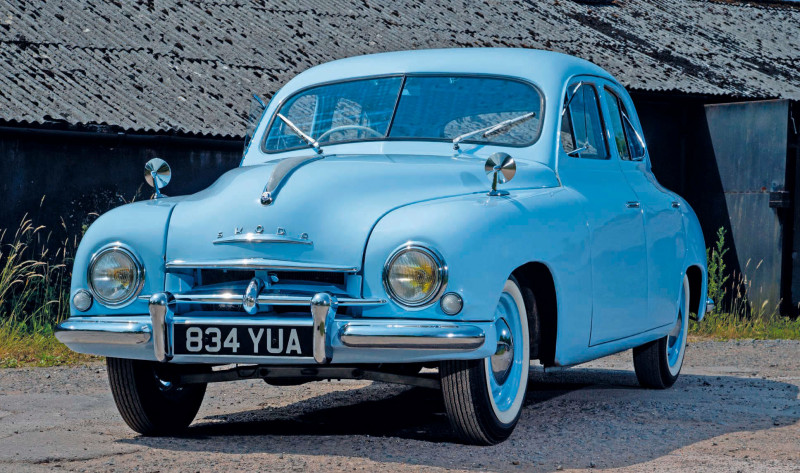
The 1200’s modern-looking Ponton-styled all-steel body sat on a sturdy welded box section frame very similar to its predecessors. Power now came from a bored-out 1213cc overhead valve inline-four rated at 36bhp at 4200rpm and drove the 1200’s rear wheels though a four-speed gearbox.
I think you could comfortably compare the driving characteristics of this Fifties’ Škoda to an early Morris Minor
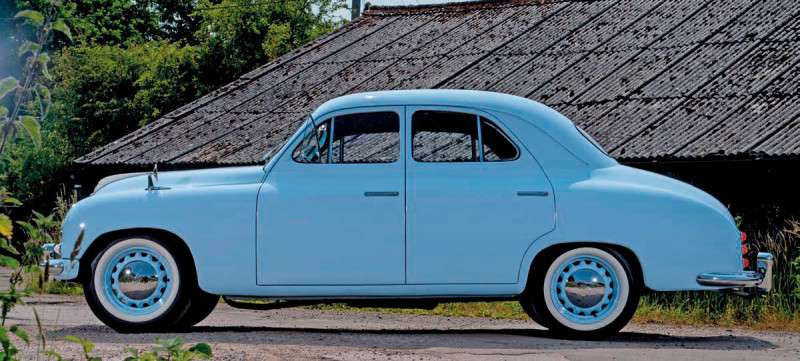
A central chassis lubrication system had been carried over from the 1101/1102 series, as had the 1200’s independent suspension setup, which consisted of transverse front and rear leaf springs and a swinging rear axle. Hydraulic drum brakes were fitted all-round and post-1955 models featured unusual amber tail lights that started to glow when the car decelerated. The more powerful 1201 replaced the 1200 in 1956 and the 1202 estate remained in production until 1970, although sales of this model in Western Europe were limited and most 1200 series cars remain in former Eastern Bloc countries.
When we came to recommission the car in the workshop, the carburettor and fuel tank were all gummed up
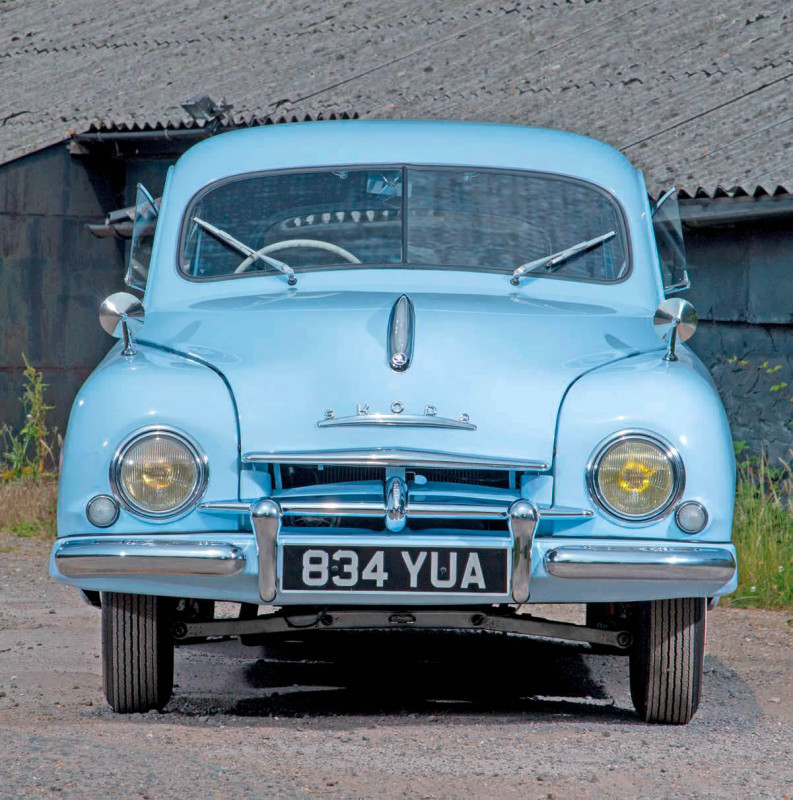
This makes this 1955 Škoda 1200 a very rare beast indeed and before being imported into the UK in 2000, the car underwent a full body off restoration in the Czech Republic about 20 years ago. Since then the car has hardly been used and we caught up with this rare Škoda in early July at the Peter James Bromley Pageant of Motoring where the car was displayed in a line up of equally smart classics with a ‘For Sale’ sign stuck inside the windscreen.
After the show, we managed to track down Trevor Cowell, the car’s current owner and he explained how his ultra rare right-hand drive Škoda had originally been displayed in a Kent-based franchised dealer’s showroom for ten years. In 2010 the car was sold to an enthusiast and registered for use in the UK for the first time, but was only driven very occasionally. Trevor, who runs Oxted-based T.J. Motors in Surrey, told us how the Škoda was a non-runner when he purchased the car earlier in the year: “When we came to recommission the car in the workshop, the carburettor and fuel tank were all gummed up.
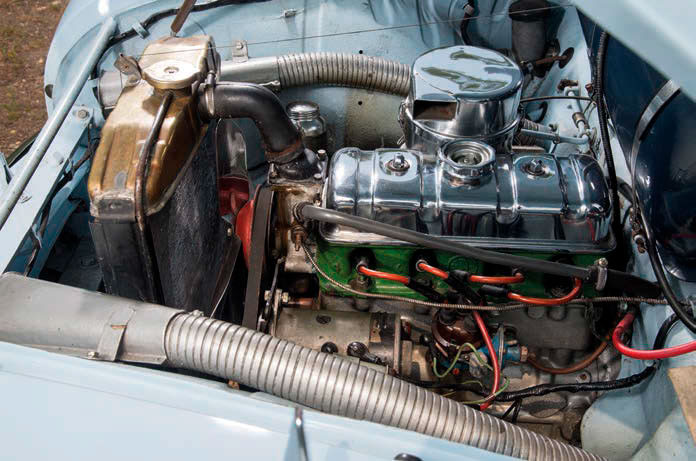
Obviously we also changed the oil and fitted a new set of spark plugs and after a bit fiddling around the engine fired up and ran really well,” he explained, who also added how there’s only 27,000km showing on the Škoda’s odometer.
Although it seemed odd that a car built and used in Czechoslovakia for most of its life should be right-hand drive, Trevor explained how the first owner had been a disabled gentleman and ordered the 1200 with right-hand drive so he could access the driver’s seat from the pavement.
The 1200’s modern-looking Ponton-styled all-steel body sat on a sturdy welded box section frame very similar to its predecessors
“Unfortunately there’s very little history about the car’s early time in the Czech Republic and I expect it had been laid up somewhere for a long time until being discovered and restored.
The restoration was a massive body off undertaking and a detailed photographic record showing all the work comes with the car,” explained the vendor before adding that a copy of the original factory build sheet shows this Škoda 1200 came off the line at Mladá Boleslav on 23 August 1955.
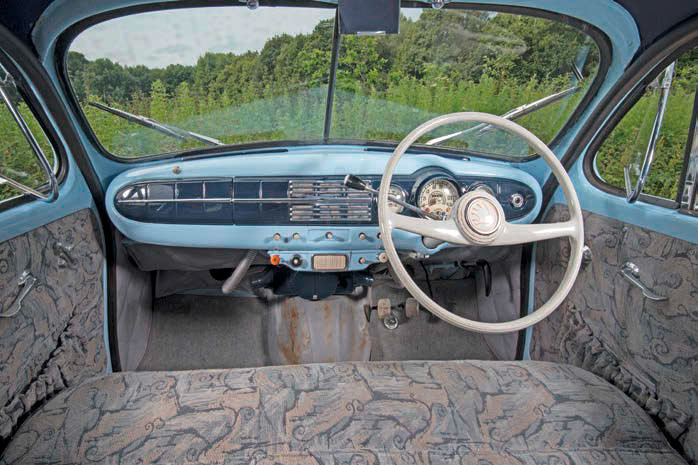
When we asked how the Škoda drove, Trevor smiled before replying: “Just like an old Škoda! The steering is very heavy at low speeds and it understeers when pushed but with only 36bhp on tap, it feels rather underpowered. I think you could comfortably compare the driving characteristics of this Fifties’ Škoda to an early Morris Minor, but it gets much more attention than a Moggie would when its out and about.”
As can be seen from the restoration images, the bodywork resembled a lace curtain after all the paint and filler had been removed. This meant that a lot of the repair panels had to be expertly formed and welded into the bodyshell to sort out the damage, especially around the front and rear light clusters. The Czech-based technicians that completed the work have done a superb job and a close inspection shows no sign of any new corrosion trying to break through the light blue paint around the repaired sections.
Although the neat-looking engine bay has been detailed with the addition of a chrome air filter and rocker cover, it’s not been overdone. One nice touch is the rolled up blind sitting at the base of the radiator, which can be raised and lowered by pulling and pushing a knob located inside on the bulkhead inside the car.
The car’s interior is sparse but a column gear change means there is plenty of space for two large adults on the smartly upholstered front bench seat. The highly decorated material used on the seat facings has been repeated on all the door panels and it would be interesting to know if this material was replaced during the rebuild or if it is still the factory-fitted original.
During the time Trevor has had this car, he’s grown to appreciate its rarity. Several online searches have only discovered a couple of left hand drive examples up for sale, but Trevor reckons you would have to travel to Prague to see them. The estates are more numerous and Škoda even built about 2000 ambulance versions based on a 1200 estate.
ŠKODA – A BRIEF HISTORY
Those cheap jokes doing the rounds back in the Seventies and Eighties tended to ignore Škoda’s impressive history that stretched back to 1859 when the Škoda Works was formed by the aristocratic Waldstein family at Pitzen to produce heavy castings for use in constructing railway industry and ship building. A decade later the business was taken over by the dynamic industrialist Emil Škoda who went on to establish the works as a major producer of heavy guns and armaments for the Austro-Hungarian military campaign.
Prior to the First World War, the Škoda Works produced the massive castings used in the construction of the locks on the Suez Canal and by 1917 the factory was employing 35,000 workers making munitions for the war effort. After the conflict, Czechoslovakia became a republic and the mighty Škoda operation was transformed into a multi-sector heavy engineering conglomerate that concentrated on manufacturing ships, railway locomotives, brewery equipment and steam turbines.
Škoda’s winged arrow in a circle trademark was registered in 1923 and a year later the company took over the Mladá Boleslav-based vehicle manufacturer Laurin & Klement. This new division was later renamed Škoda Automotive and the plant continued to build cars and light commercials until the Nazis occupied Czechoslovakia in 1939. During the Second World War the factory was renamed Reichswerke Hermann Göring and produced a variety of vehicles and tanks for the German military.
The factory at Mladá Boleslav was heavily targeted throughout the conflict by the Allied air forces and by 1945 all that remained of the Škoda Works was a bombed out heap of rubble. An area of the rebuilt plant was subsequently separated from the Škoda Works and became part of the country’s communist planned economy. By 1946 Škoda Auto had started to build cars again and introduced an updated version of the pre-war designed Popular badged as the 1089cc body-on-frame 1001/1102 series. Although Škoda Auto was now cut off from the white hot heat of Western automotive technology, the company went on to produce a range of rugged cars that included the 1200, the high compression 1201 and larger capacity 1202 followed by the restyled 440, 445 and Octavia.
From 1964 Škoda brought itself up to date with a rear-engined model called the 1000MB. Available with four doors, or as an optional MBX Coupe, Škoda replaced the MB with the Škoda 100 in 1969.
Rear-engined Škodas were produced in the Seventies and Eighties (when the company was known as AZNP) and these models attracted attention in the UK for all the wrong reasons. But it was all change when the Bertone-designed Favorit broke cover in 1987. This Western-influenced mid-sized front-wheel drive hatchback marked a huge turning point in Škoda’s fortunes and although the technology gap was still there, the very capable Favorit sold well in the UK due to its low price.
As communism fell out of favour in Czechoslovakia, most of the country’s large industries ended up being privatised and in March 1991 a joint venture agreement was signed between Škoda Automotive and the Volkswagen Group. Just over a quarter of a century later, Škoda has established itself. It is now a hugely successful brand in the UK and has recently introduced an impressive line up of all-wheel drive SUVs. These technically advanced crossover vehicles are light years away from those rear-engined models all those ill-informed bar room comedians enjoyed mocking so much, which means the last laugh is now firmly with the directors of Škoda Automotive.


